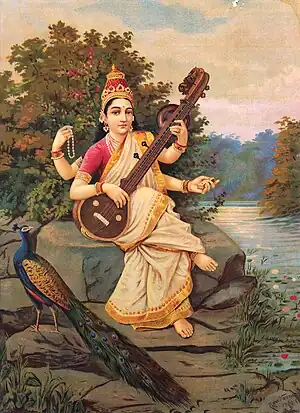Riyaz (lit. 'training, practice') is the systematic practice of music, dance or any other art form usually under the guidance of a teacher or preceptor.[1][2][3][4] In Hindustani classical music tradition, it is employed as a repertoire of exercises to cultivate the musicality of one's voice or fingers.[5] It is known as Sadhakam or Sadhana in Carnatic music.[6][7] It is followed rigorously by the students as well as exponents of vocal as well as dancing forms.
The practice
The Riyaaz or Sadhakam, which often starts early in the morning at four,[8] is taken seriously by the students for it requires intensity, discipline and commitment for years and forms an important component in the Guru - Shishya parampara (teacher-student tradition).[9]
In Carnatic music, the impression is that the assiduous sadhakam of the Trinity of Carnatic Music was the bedrock of the excellence of the old-world vidwans.[10]
A popular system for practice of the tabla, known as chilla, is mostly followed by Muslim exponents of music and involves 10–12 hours of daily riyaz for 40 days.[2]
Further reading
- The shaping of an ideal Carnatic musician through sādhana - Pantula Rama
References
- ↑ Mahābhāratī, Saṅgīt (2011). "Riyāz". In Ghosh, Nikhil (ed.). The Oxford Encyclopaedia of the Music of India. Vol. III: p–z. Oxford University Press. doi:10.1093/acref/9780195650983.001.0001. ISBN 9780195650983. OCLC 670482237. Retrieved 23 May 2021.
Urdu term for systematic practice of music, dance, or any other art form. In simple terms, riyāz means training, practice, rehearsal, etc. using a prescribed procedure usually under the guidance of a teacher or preceptor.
- 1 2 Naimpalli, Sadanand (2008). "Riyaaz". Theory and Practice of Tabla. Popular Prakashan. p. 51. ISBN 9788179911495. Retrieved 21 May 2021.
This is an Urdu word which means practice. ... The most popular and result oriented system of riyaaz is known as "Chilla". This is mostly followed by Muslim proponents of music ... lasts for 40 days and involves 10 to 12 hours of assiduous riyaaz everyday.
- ↑ Raju, Anupama (20 November 2021). "Practice Makes Perfect". Education. The Hindu. THG Publishing. ISSN 0971-751X. Retrieved 7 February 2022.
The words riyaz in Urdu or sadhana in Sanskrit mean disciplined and structured practice under a teacher's guidance, in the context of music.
- ↑ Platts, John Thompson (1884). "riyāẓ" ریاض. A dictionary of Urdu, classical Hindi, and English. London: W. H. Allen & Co. p. 610. ISBN 0-19-864309-8. OCLC 56611364. Retrieved 21 May 2021.
- ↑ Raqs Media Collective (2009). "How to be an Artist by Night". In Madoff, Steven Henry (ed.). Art School: (Propositions for the 21st Century). Cambridge, Mass.: MIT Press. pp. 76–77. ISBN 9780262134934. OCLC 471874683. Retrieved 21 May 2021.
- ↑ "The Riyaz Shows". The Hindu. Archived from the original on 1 July 2008. Retrieved 16 January 2012.
- ↑ "Talas of Virtuosity". The Hindu. Retrieved 16 January 2012.
- ↑ "Bonding with the Gurus". The Hindu. Archived from the original on 14 July 2008. Retrieved 16 January 2012.
- ↑ "Music is the only Constant in my life:Asha Bhosle". Indian Express. Retrieved 16 January 2012.
- ↑ "Bakti and sadhaka - Pillars of Excellence". The Hindu. Archived from the original on 14 February 2002. Retrieved 16 January 2012.
![]() The dictionary definition of riyaz at Wiktionary
The dictionary definition of riyaz at Wiktionary
